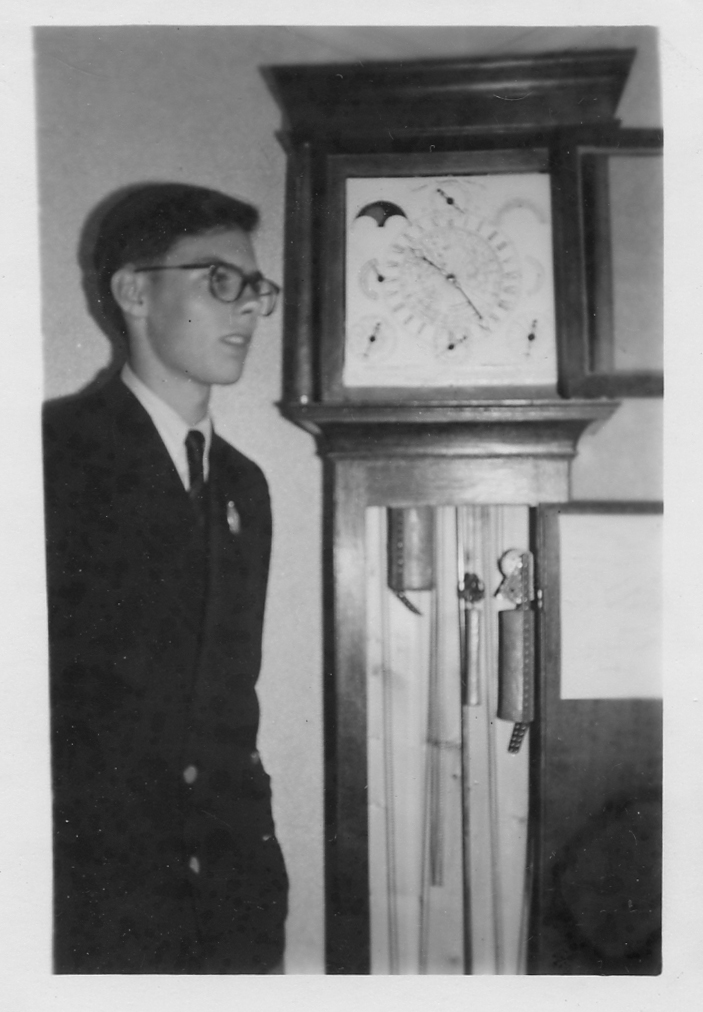
By
Michael Finnemore
Featured on a BBC live television show called "All Your Own" with Huw Weldon. May 1st 1955.
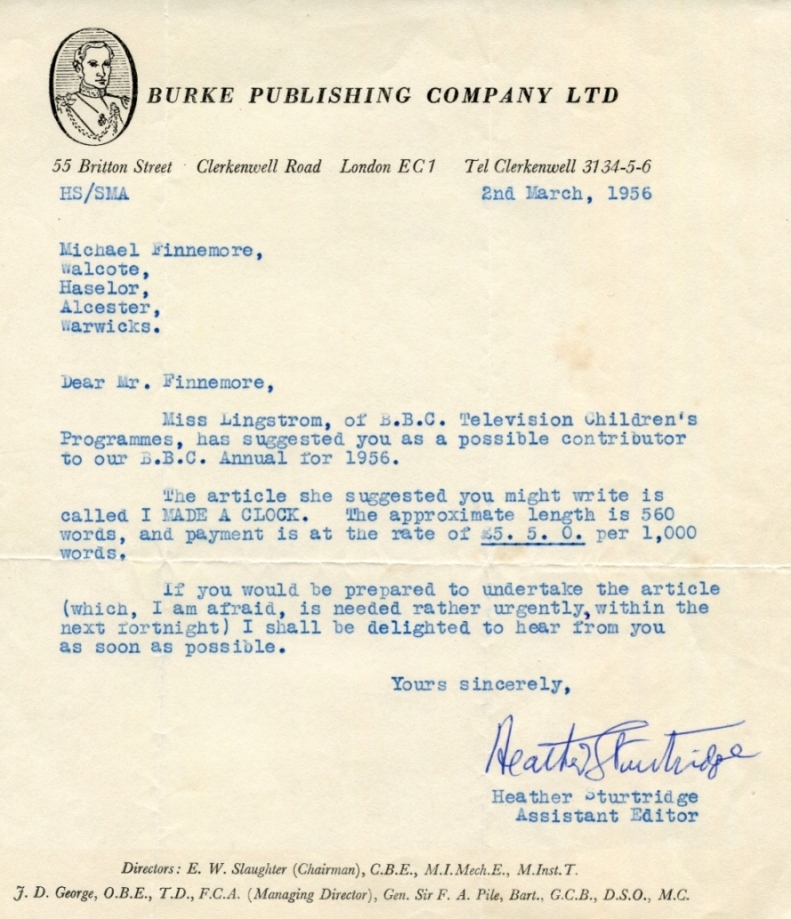
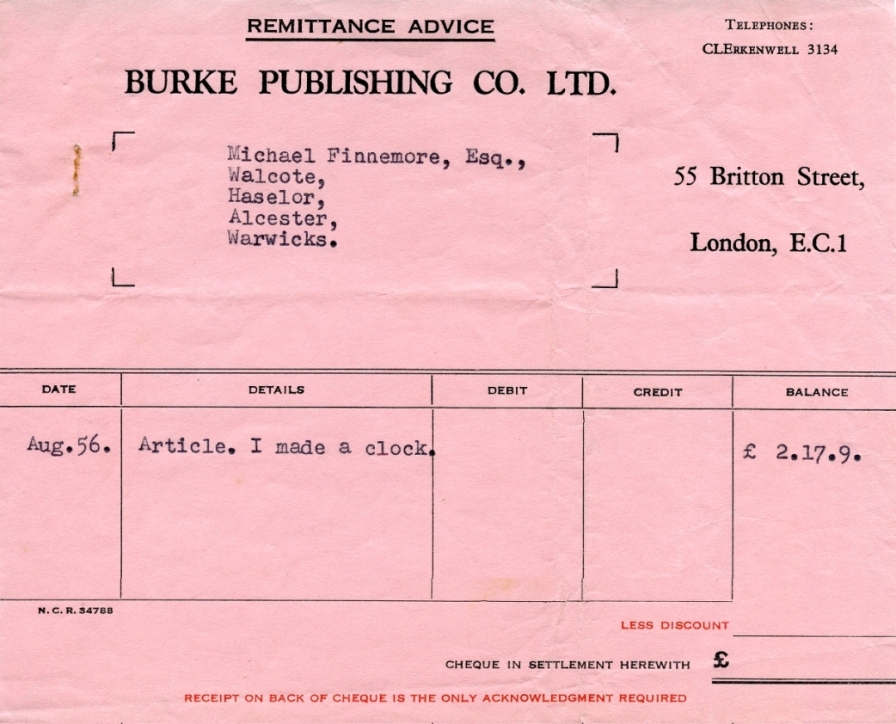
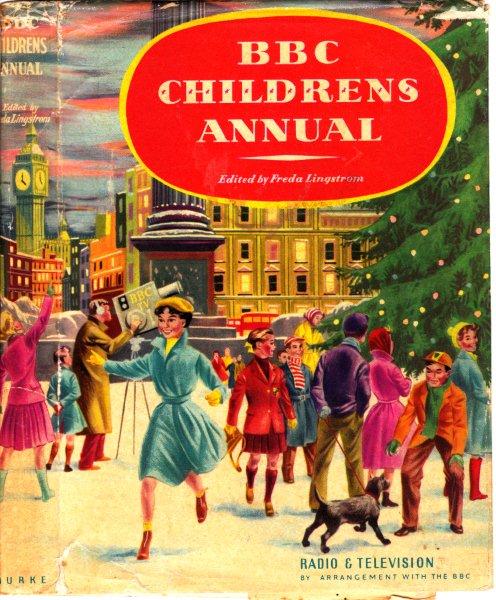
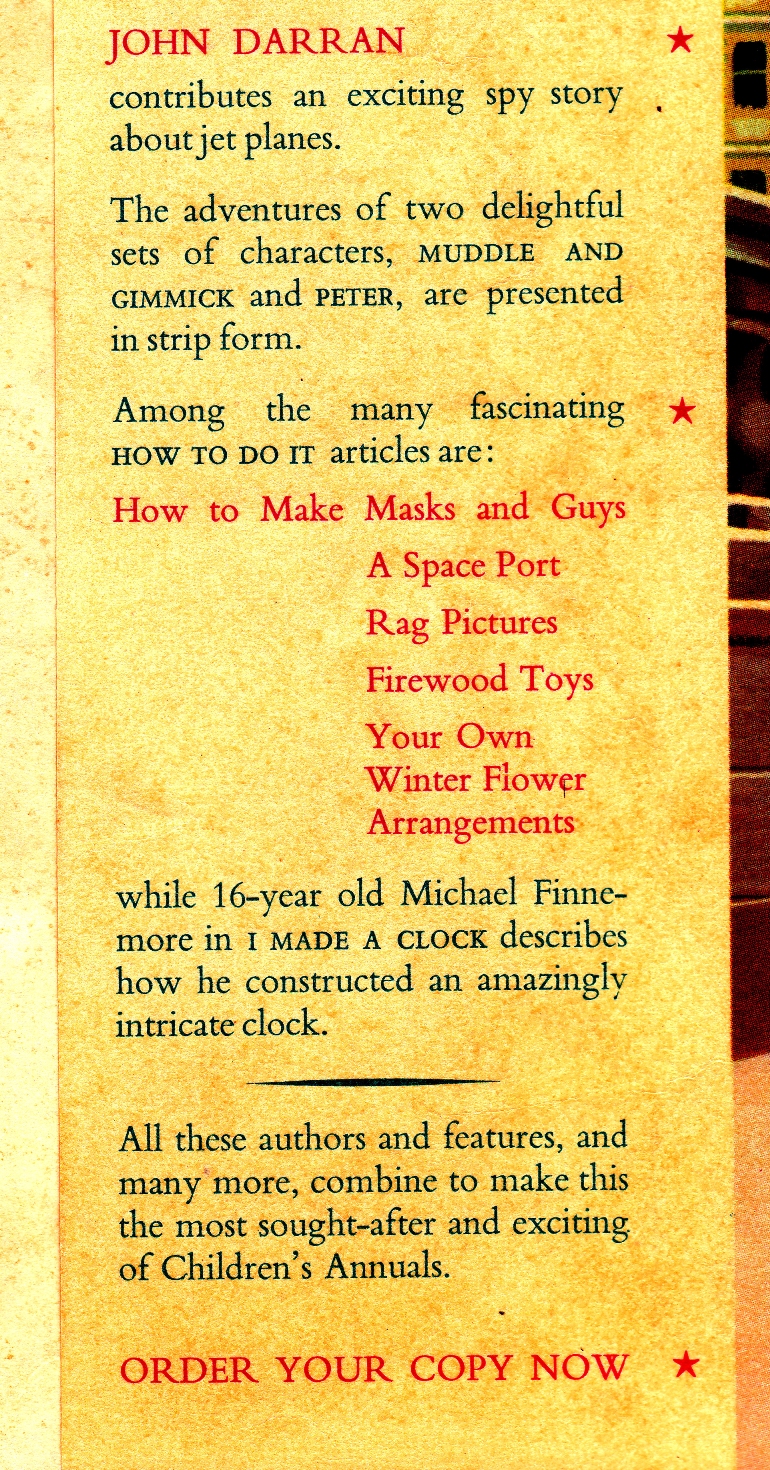
 |
I MADE A CLOCK By Michael Finnemore Featured on a BBC live television show called "All Your Own" with Huw Weldon. May 1st 1955. |
||
| This Meccano clock was a sensation and still ticking after 60+ years. | |||
 |
 |
||
| If the payment rate was £5. 5. 0. for 1000 words, then how many words did Michael write for a payment of £2. 17. 9.? | |||
|
|
|||
 |
 |
||
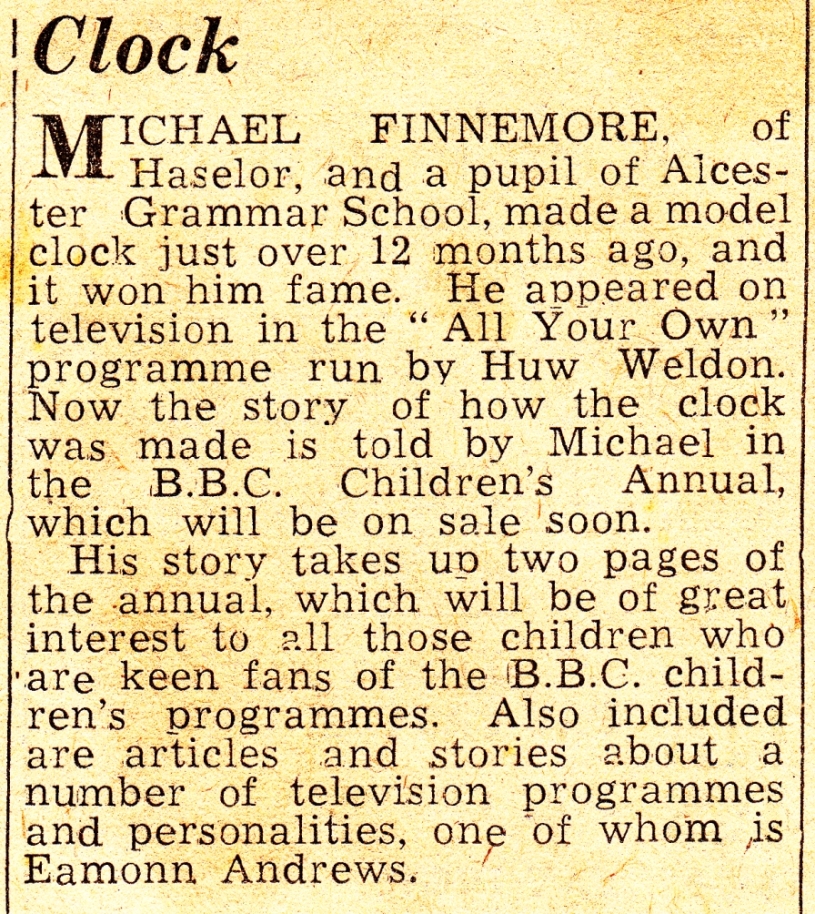 |
|
| 1956 | |
| I MADE A CLOCK Written for the BBC Children's Annual 1956 - 1957 |
|
 |
|
| The artist chose his own design for the case! | |
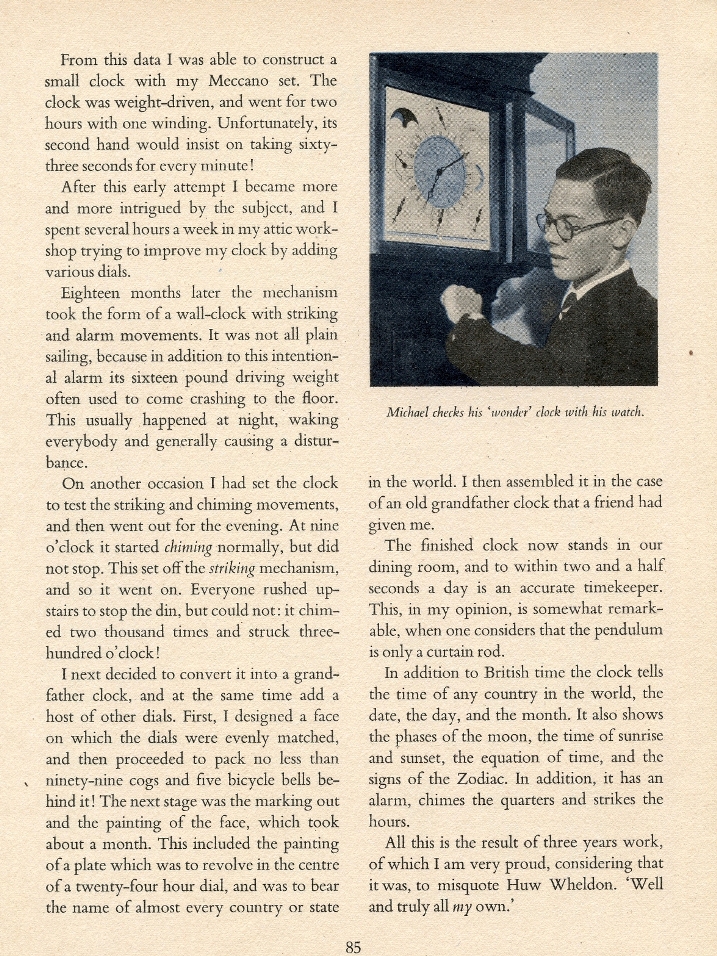 |
|
| The Making Of A Clock Started Around 1951/52 | |
|
|
HIS “WONDER” TIMEPIECE
Michael reminded me (brother John) that I had built a clock from a Meccano
instruction book and that he copied me and built the same clock.
He found that his clock was not as good as mine because I had a better
clockwork motor. This was a very simple clock that did not go for
many hours.
While I
was away at boarding school, Michael set about improving his clock by
turning it into a wall clock driven by weights. His clock then went for
more than a day. To improve it more, he added striking the hours
and chiming every quarter. There was also an alarm.
There was a lot of testing on the length of pendulum. During the
night, on several occasions, the sixteen pound weight fell to the floor.
My little sister Pam, sleeping below would be woken up, covered in bits from
the beam in the ceiling!
To add more gadgets, Michael had to design a clock-face that would fit
into an old grandfather clock-case that Eric Bunting had given him. When
he was sure that he could put all the mechanism needed into such a
compact space, he then made the clock-face. |
| This first article is from the Alcester Grammar School Magazine. | |
| It is when the clock was now a wall-clock, chiming every quarter and striking the hours. It also had an alarm. | |
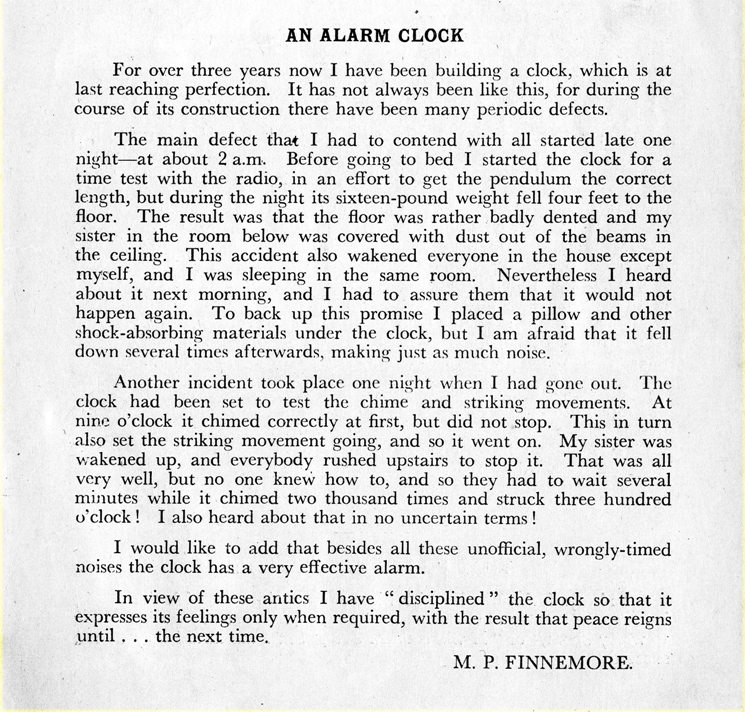 |
|
| In the newspaper cutting, it states that ("there is a slight difference because the earth is not quite round"). This is incorrect. It is because of the orbit of the earth around the sun. | |
| The next stage was to convert the wall-clock into a grandfather clock and add many more features. | |
|
|
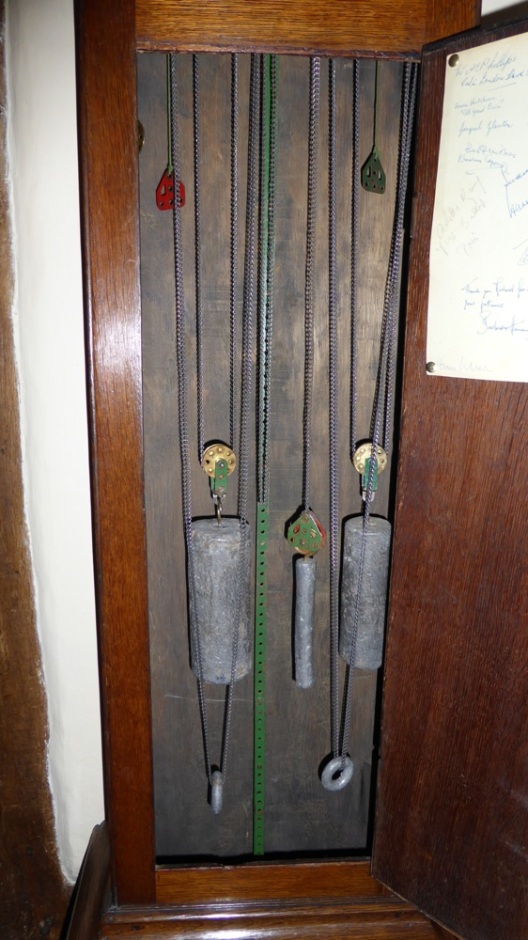 |
| Michael with his clock that now stands in the kitchen of an old manor farmhouse in Buckinghamshire. | Meccano strips bolted together have replaced the
original brass curtain rod for the pendulum. The door of the clock is not that shape. It must be the way I photographed it! |
| ------------------------------------------------------- | |
|
The art teacher,
Mrs Harrison at Alcester Grammar School wrote to the BBC about Michael’s
clock and 3 weeks later a telegram arrived. Dated 7th April 1955.
|
|
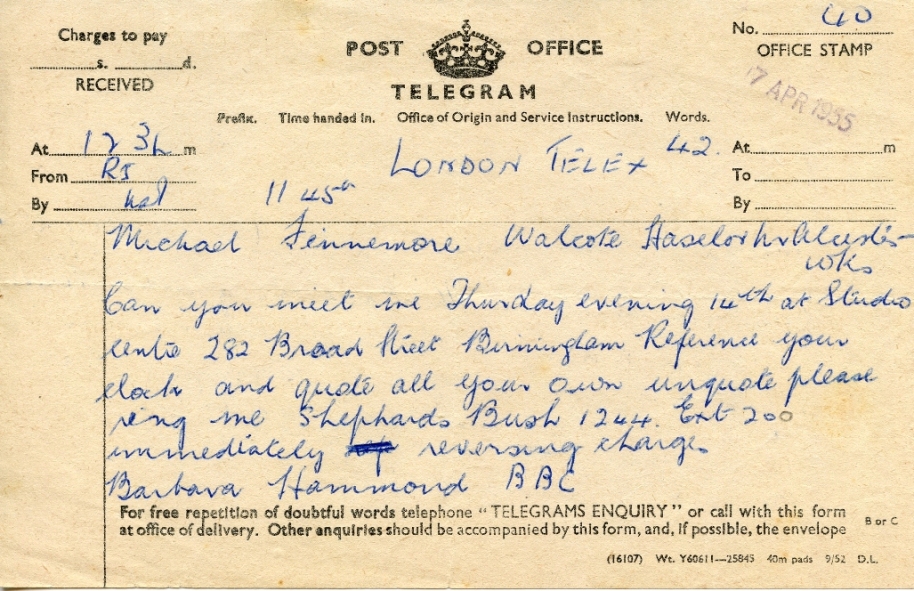 |
|
| MY TELEVISION DEBUT | |
| As written for the Alcester Grammar School Magazine by Michael Finnemore. July 1955 | |
|
It was very nearly dinner-time on the first day of the Easter holidays, and I was already beginning to feel bored. Then there was a knock at the door and to my surprise a telegram for me. (Dated 7th April 1955.) I
was even more surprised when I read it, to find that I was to ring
Shepherds Bush immediately with regard to my clock. I had a slight
notion what it was about, because Mrs. Harrison, our art teacher, had written up to
the B.B.C. about my clock only three weeks before, but we hardly
expected anything to come of it.
|
|
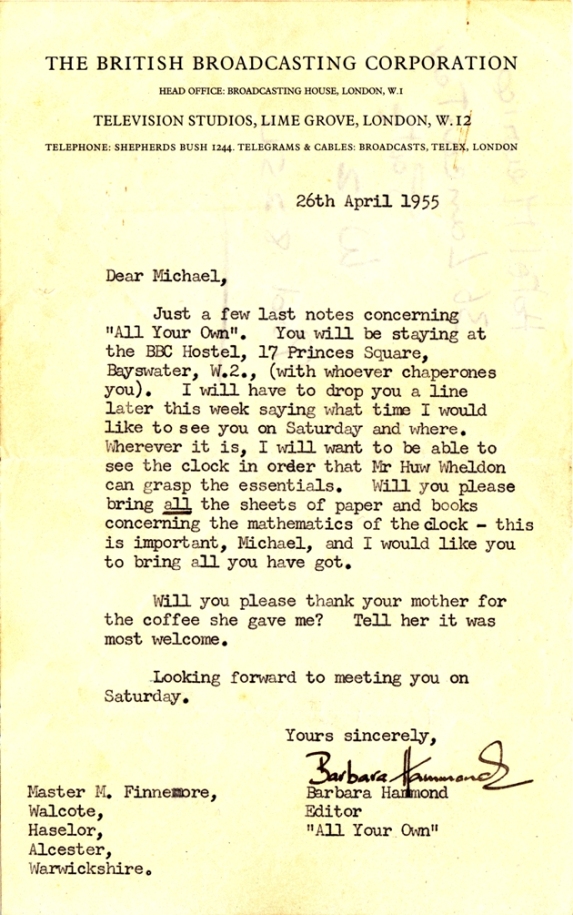 |
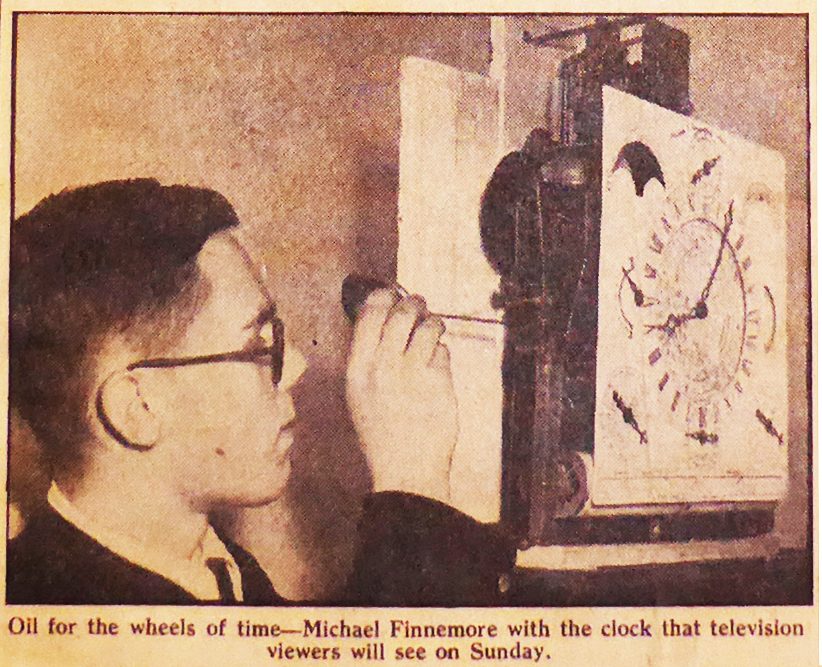
All His Own
A Clock Built from ‘Scroungings’
In a corner of the dining-room of an old farmhouse at
Walcot, Haselor, near Alcester, stands a neat grandfather clock, with an
unusual and elaborate face. To-morrow the clock will be dismantled,
packed into the family car and its 16-year-old constructor and his
father will set out for London.
On Sunday afternoon television viewers will see and
hear Michael Finnemore demonstrate this product of his acute mechanical
mind and clever hands in a programme
All Your Own.
The clock shown here, chimes at each quarter and
strikes the hours, but has a lever to check all this if desired. It
gives the date, and indicates the phases of the moon and signs of the
Zodiac. It gives the current
G.M.T. of sunrise and sunset, and shows the small variation between
sundial time and G.M.T.
The hour hand moves round once in 24 hours and a
superimposed disc gives the correct time practically anywhere in the
world. A second hand has been included.
The mechanism has “99 cogs and bicycle bells, curtain
rods, bits of pump and various other scroungings went into the works.”
Michael is the second son of Mr. and Mrs. Philip T.
Finnemore, and a pupil at Alcester Grammar School.
Copied from the Birmingham Post
|
| The letter above says | |
|
Will you please bring all the sheets of paper
and books concerning the mathematics of the clock - this is important
Michael, and I would like you to bring all you have got. |
|
|
|
 |
| Telegram dated Thursday 28th April 1955 | |
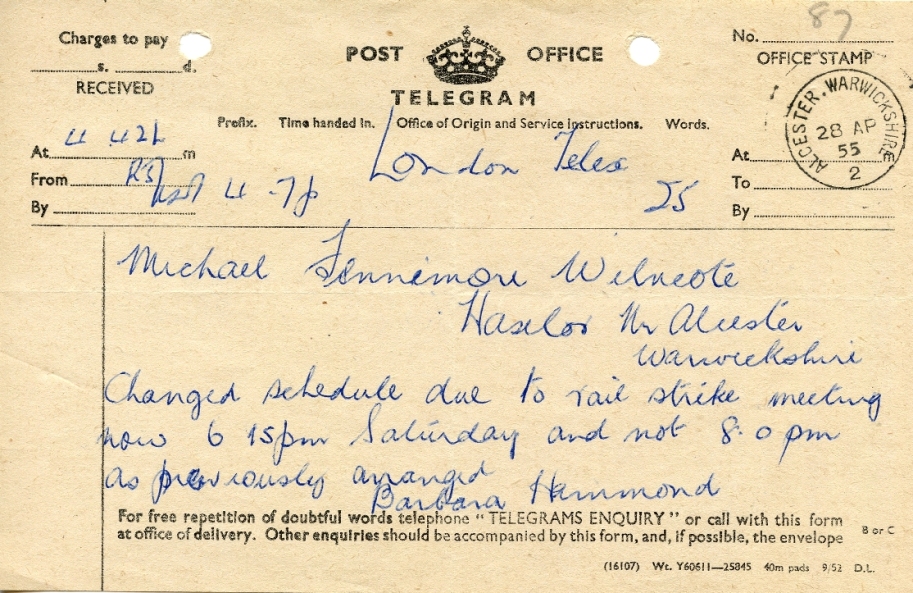 |
The BBC Hostel, 17 Princes Square, Bayswater, London
W2, that the BBC had booked for Michael and my father, was
no longer available because the people who were staying there in the
week to go to work, were unable to go home at the weekend because of a
rail strike. They were then booked into the Hotel Meurice, 36 Lancaster
Gate, London W2. |
|
This is the time that Michael had to be at the BBC Television Studios with the clock in London on Saturday 30th April 1955. The next day will be the live broadcast of "All Your Own" on Children's Hour. |
|
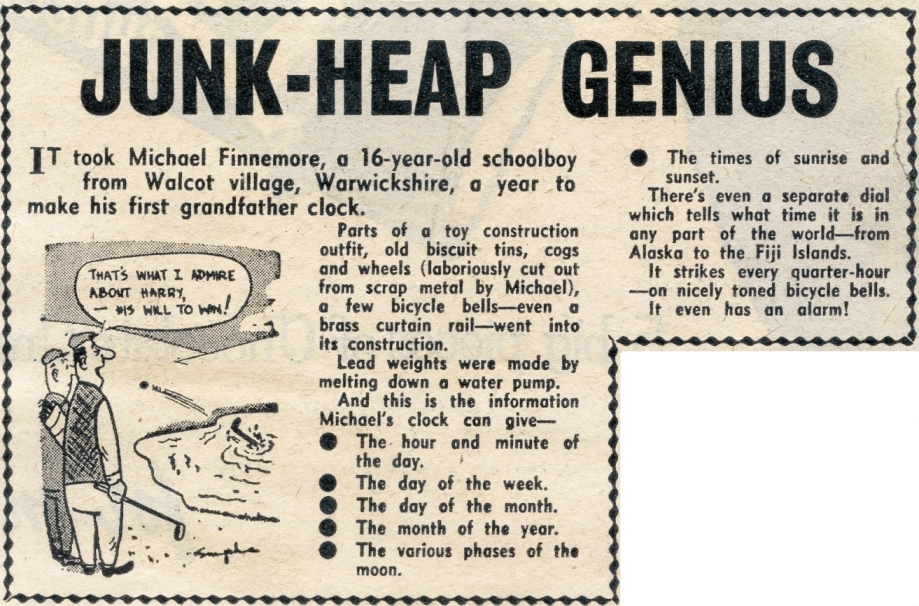 |
MY TELEVISION DEBUT
|
|
A Very Amusing Story On Car Parking
Near The Hotel, But One Person
Didn’t Think So! |
|
|
Arriving at an indoor car park, near the hotel, late
at night, the car park attendant
wanted to park the car himself but my father wouldn’t let him.
The attendant got very annoyed with my father and he then decides to
race round to the other side of the car, opens the front passenger door
and jumps in.
There was one almighty howl, then shrieking with pain.
What
he hadn’t realised was that there were only metal brackets sticking up
from the floor because the front seat had been removed to make space for
the clock!
The car was the first new car that my father had
bought and the waiting time to get one, took years after the war. It was
the top of the range Wolseley 6/80 and had a six cylinder engine, the
gear change was on the steering column and the handbrake was near the
driver’s door. It had leather seats and it even had a fitted heater! A
lot of police forces had this make and model of car. The car was my
fathers’ pride and joy and no stranger was going to drive it, and
especially for a tip! |
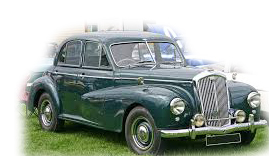 Wolseley 6/80 |
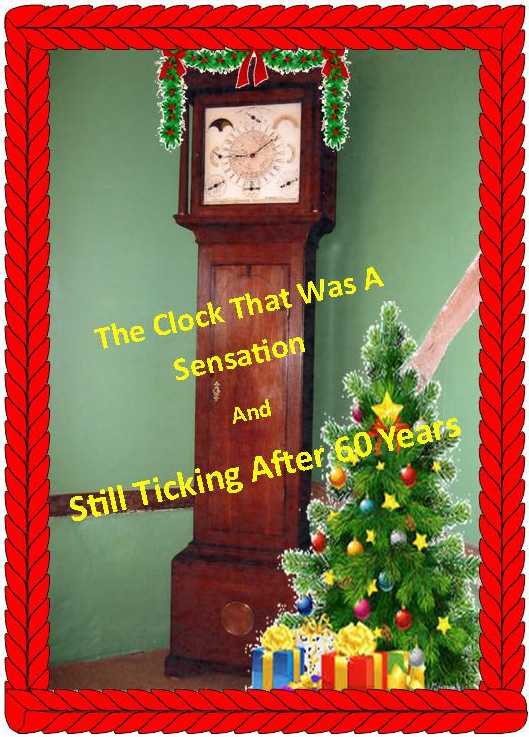 |
|
|
MY TELEVISION DEBUT
After I had reassembled my clock once more we had a
rehearsal which was mainly for the benefit of the cameramen, so that
they could get their positions after each item. They were televising us
and we could see ourselves on the monitors, but they were not
transmitting it. In the afternoon we had another rehearsal, which
was a complete run through of the afternoon's programme. After this I
set the clock ready for the actual programme, and then we went for tea.
It was now about twenty to five, and before I had even drunk my tea, I
heard this over the loud speaker system: "Will the owner of the
grandfather clock come to studio E immediately." At once the thought
that it had been knocked over crossed my mind and I began to get
worried. When we reached the studio after getting lost on the way, we
found that it had only been knocked, and, as a result, it had set the
pendulum vibrating at a terrific rate. In five minutes it had covered
three hours to the accompaniment, of course, of the chimes and strikes.
All I had to do was to steady the pendulum; at which the astonished
onlookers remarked: "We thought of doing that, but we thought we had
better not touch it." Soon after we had finished tea the programme went
on the air and the moment I had been waiting for, for three weeks was,
at last, materialising. Nevertheless, my worries were not over yet,
because, in running round the back of the cameras to get to me, Huw
Wheldon tripped over a cable and landed at my feet. He managed to get up
just in time and the viewers received no indication of what had
happened. Taking things all round, we had a very interesting
and enjoyable week-end, and I might add, for the benefit of some
humourists, that as far as I know, shares in the TV tube trade have not
gone up. M. P. FlNNEMORE (VA). |
|
| This photograph was used to make a Christmas card. | |
|
The BBC received a phone call while the television programme was still on air. |
|
It was only from Baron Rothschild offering Michael a job in his clock manufacturing company! |
|
McDonald Hobley the well-known television presenter
telephoned the message to the studio after the live broadcast had
finished. The “All Your Own” programme, each week featured about 5 children demonstrating their talents or showing off their collections. It was on Children’s Hour between 5.00—6.00pm. Harry Corbett & Sooty was on first and then at 5.20pm “All Your Own”.
|
| After the programme there was signature signing. |
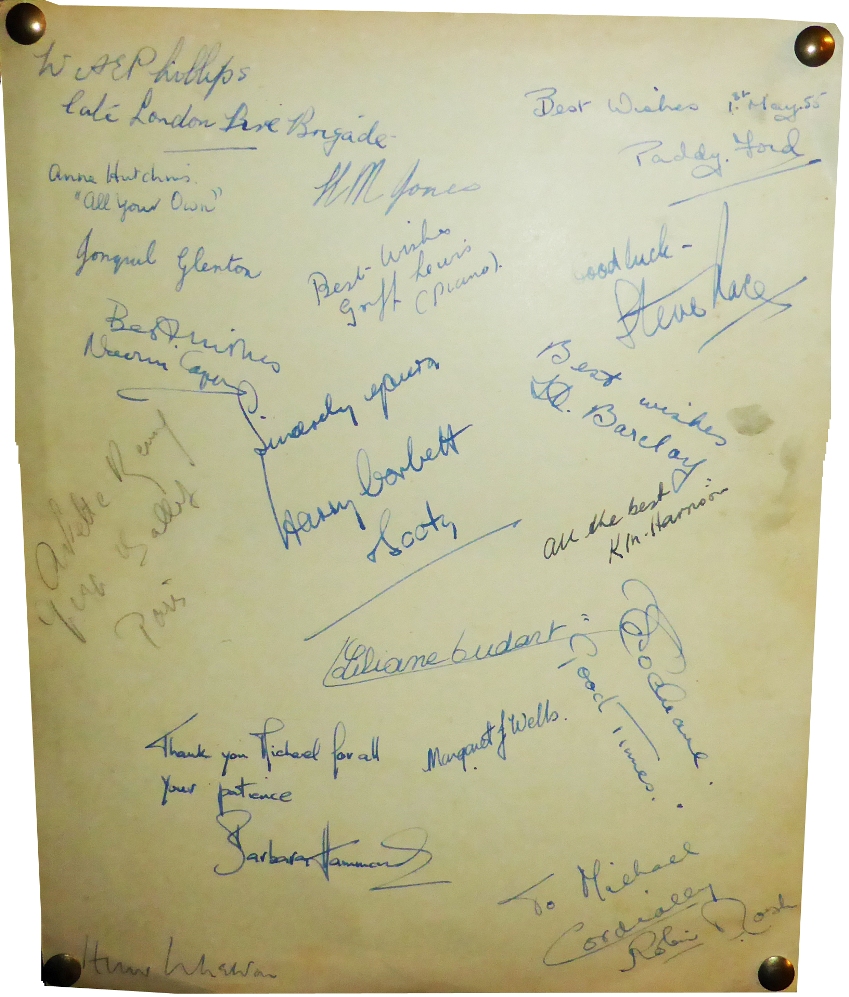 |
 |
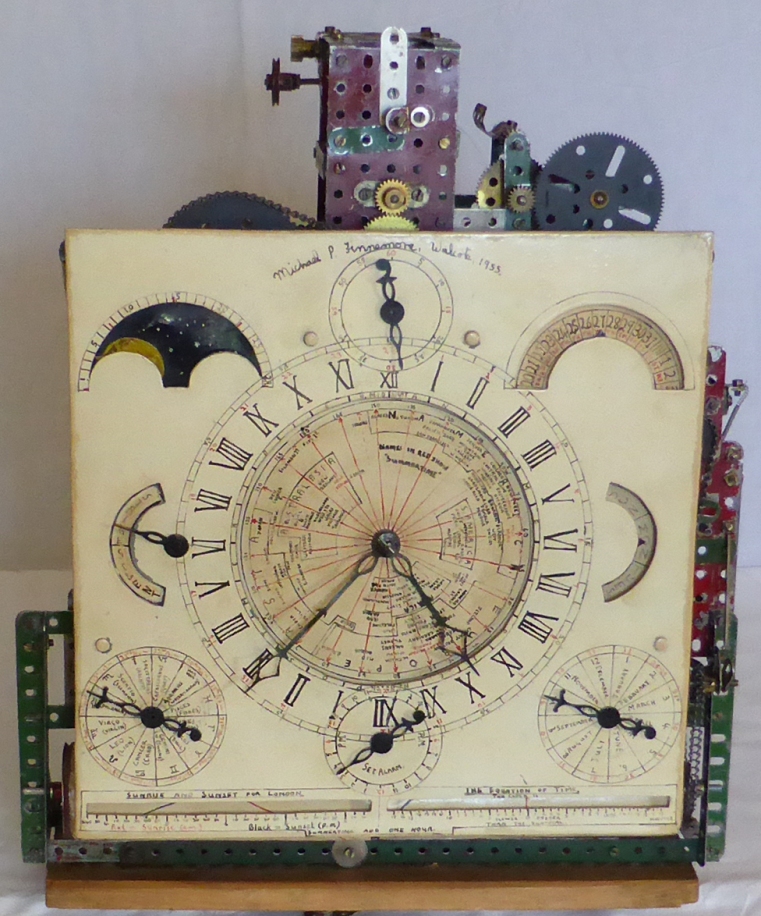 |
|
The Face of the Clock is made of Galvanised Metal from a Water Trough |
|
Phases of the Moon |
Seconds |
Days of the Month |
|
|
Strike or Silent |
24 Hour Clock with Time in all parts of the World |
Days of the Week |
|
|
Signs of the Zodiac |
Alarm |
Months of the Year |
|
|
Sunrise and Sunset for London |
The Equation of
Time |
||
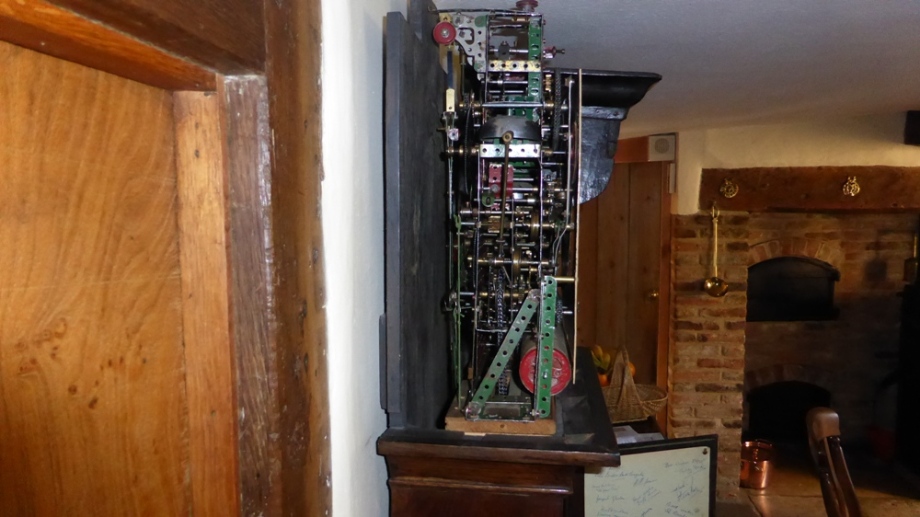 |
|
|
The Compact Movement On This Meccano Clock That People Find
Unbelievable. |
|
|
There are 3 bicycle bells which are placed vertically for the chimes.
The chimes increase in length every quarter of the hour. |
There is one bicycle bell that strikes the hours and just underneath in
the middle of the movement is another bell that rings the alarm. |
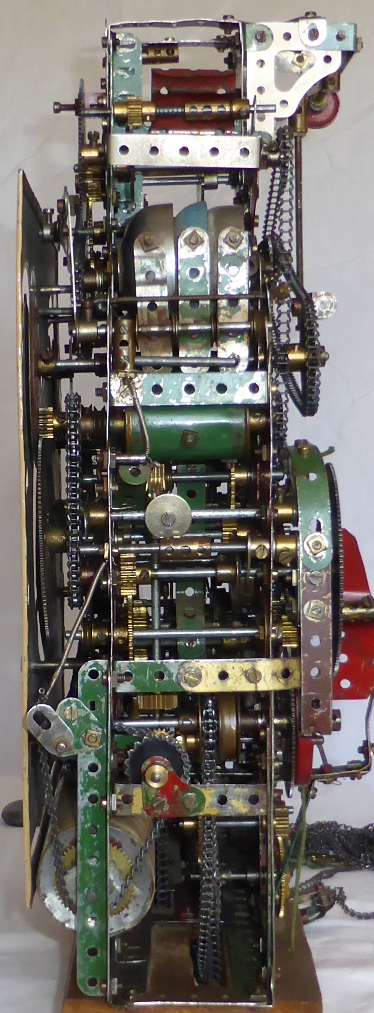 |
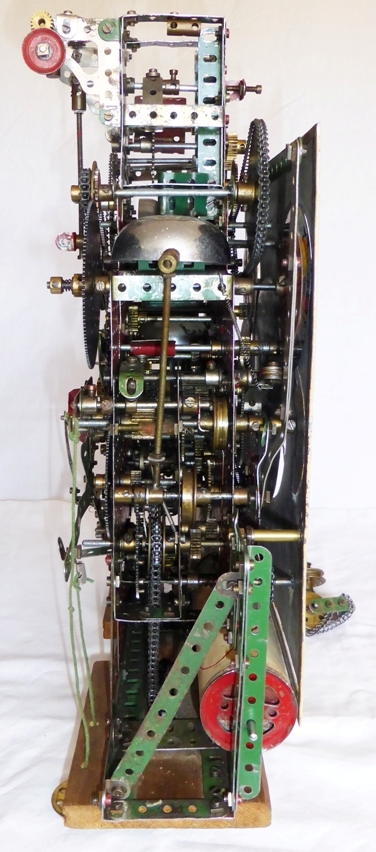 |
| ----------------------------------------- | |
| The Back Of The Clock Mechanism (the correct term is movement) With The Pendulum Removed. | |
| There are 99 cogs in the clock. There are gear cogs which mesh with other gear cogs and there are sprocket wheels that mesh with chains. Most grandfather clocks have a striking train and a going train with 2 weights. This clock has a 5 train movement with 3 weights. | |
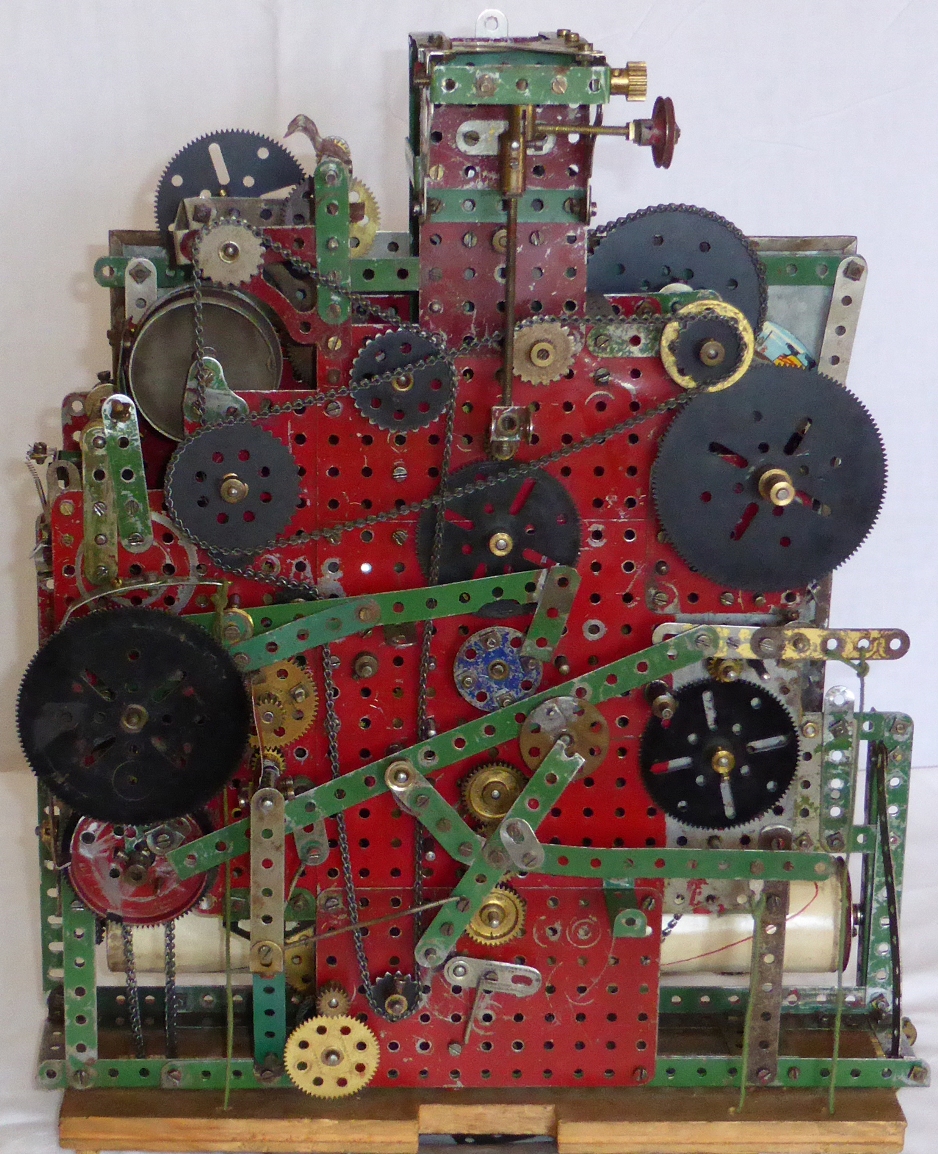 |
|
| ------------------------------------ | |
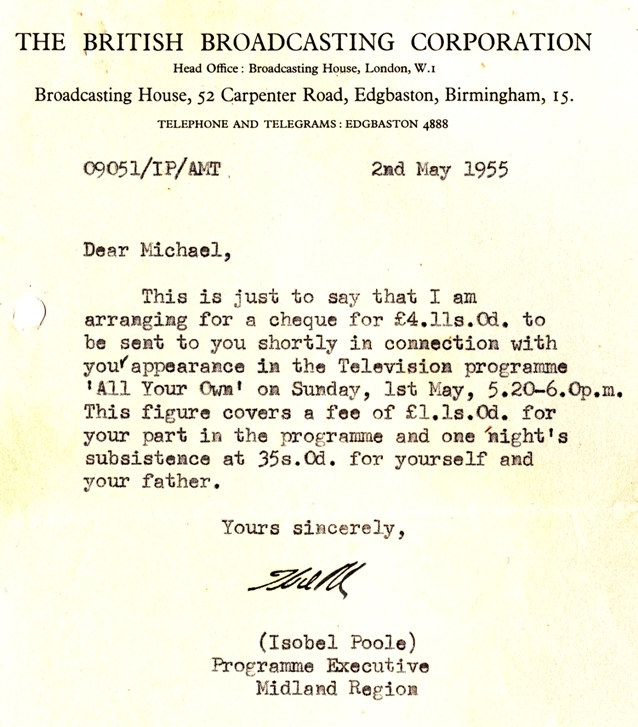 |
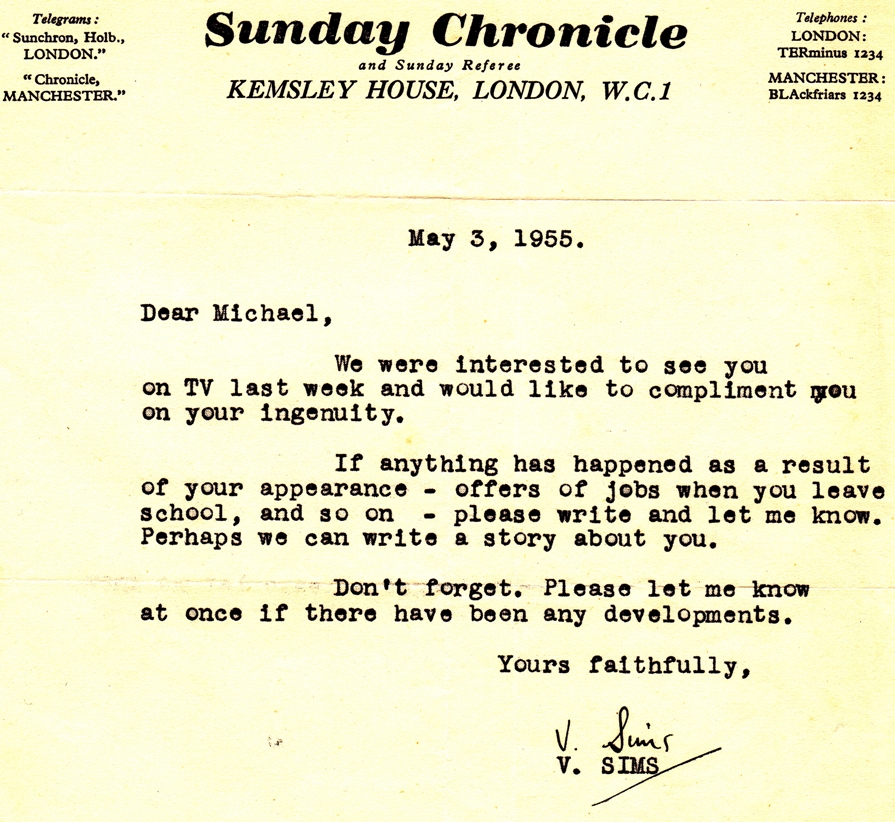 |
| The hotel bill of 35s. 0d. each is £3.50 for two people in today's money. | |
| After the programme there were letters offering Michael clock making tools and old clocks. People wanted information and clock repairs done. They also wanted to come and see the clock in a farmhouse situation. | |
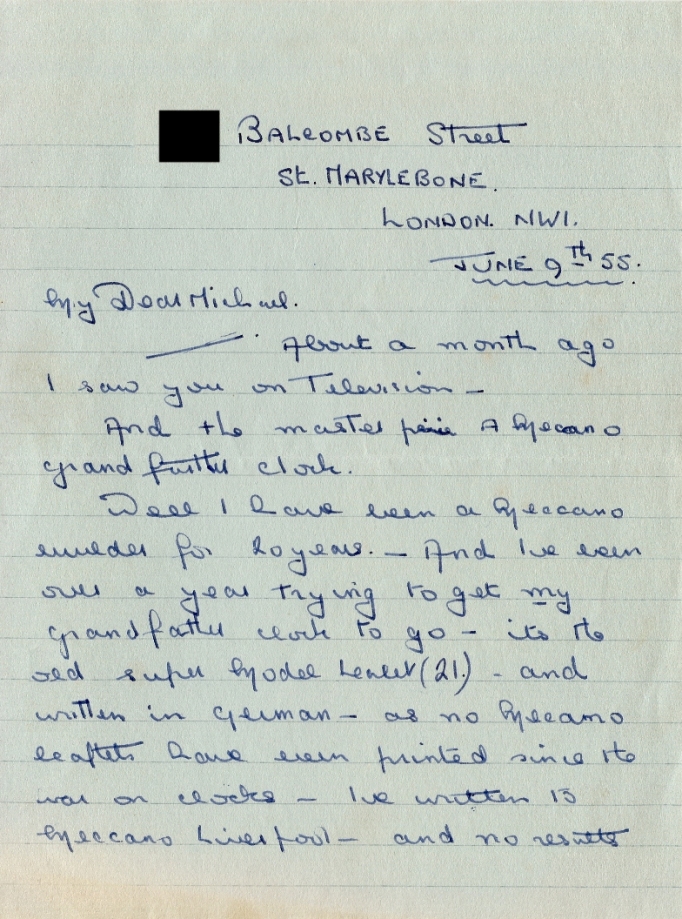 |
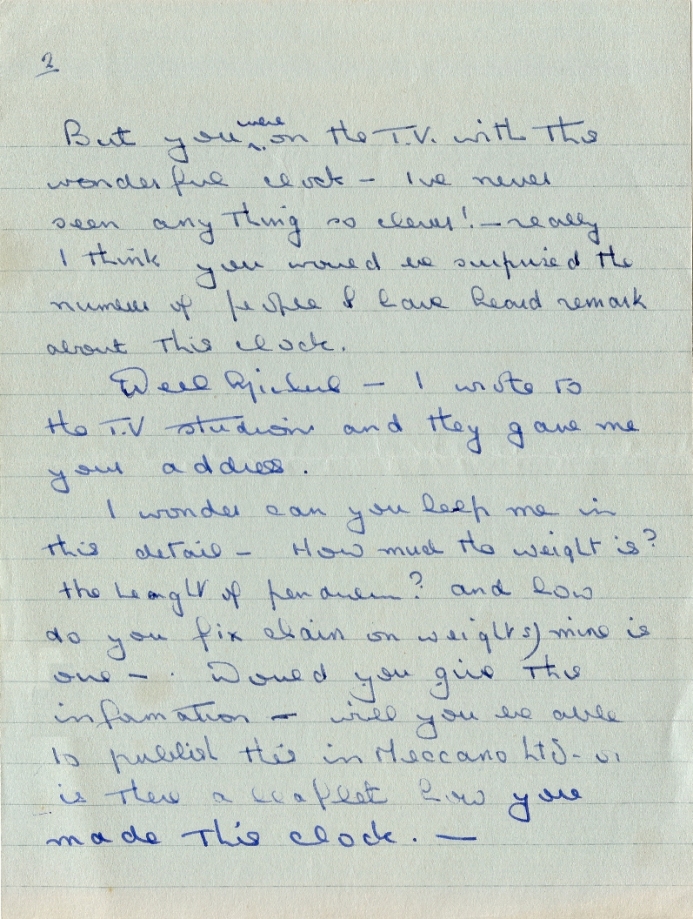 |
| Page 2 | |
|
My Dear Michael.......... About a month ago I
saw you on Television....... And the master piece A Meccano grandfather
clock. |
But you were on TV with this wonderful
clock...... I've never seen anything so clever!...really I think you
would be surprised the number of people I have heard remark about this
clock. |
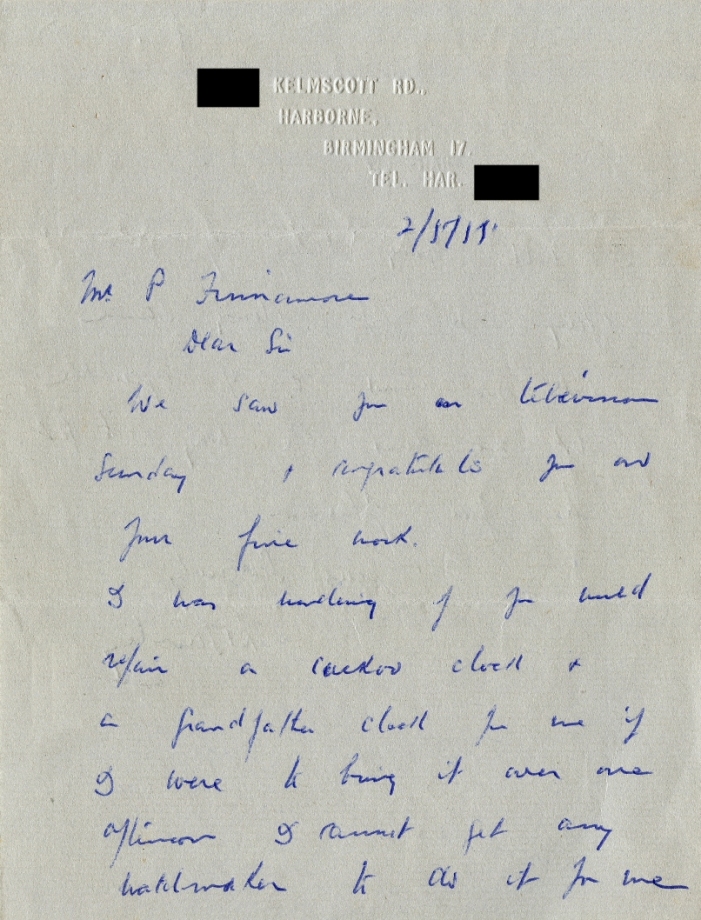 |
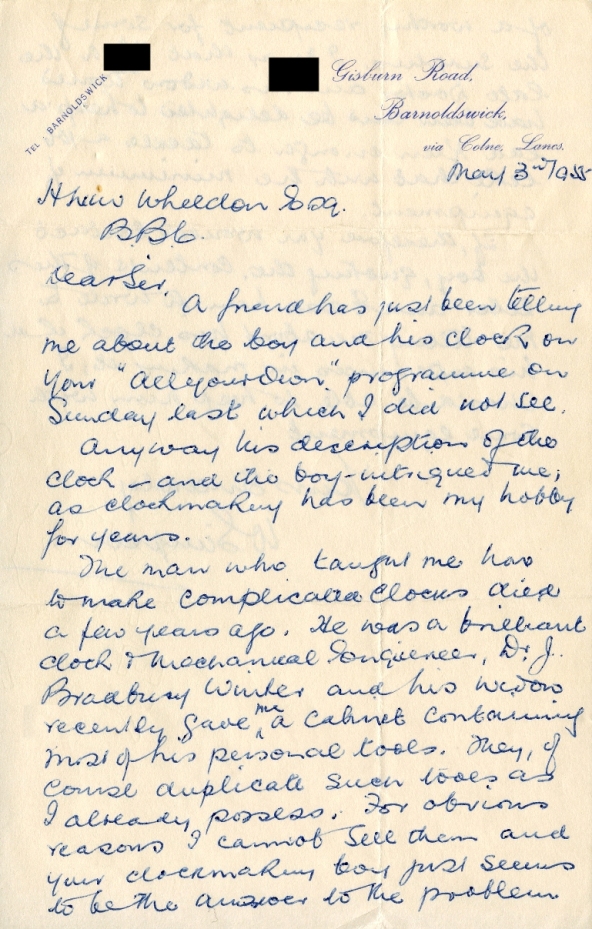 |
| We saw you on
television Sunday & congratulate you and your fine clock. I was wondering if you would repair a cuckoo clock & a grandfather clock for me if I were to bring it over one afternoon. I cannot get any watchmaker to do it for me |
|
|
|
|
| Some people did not have their own television set in 1955. | |
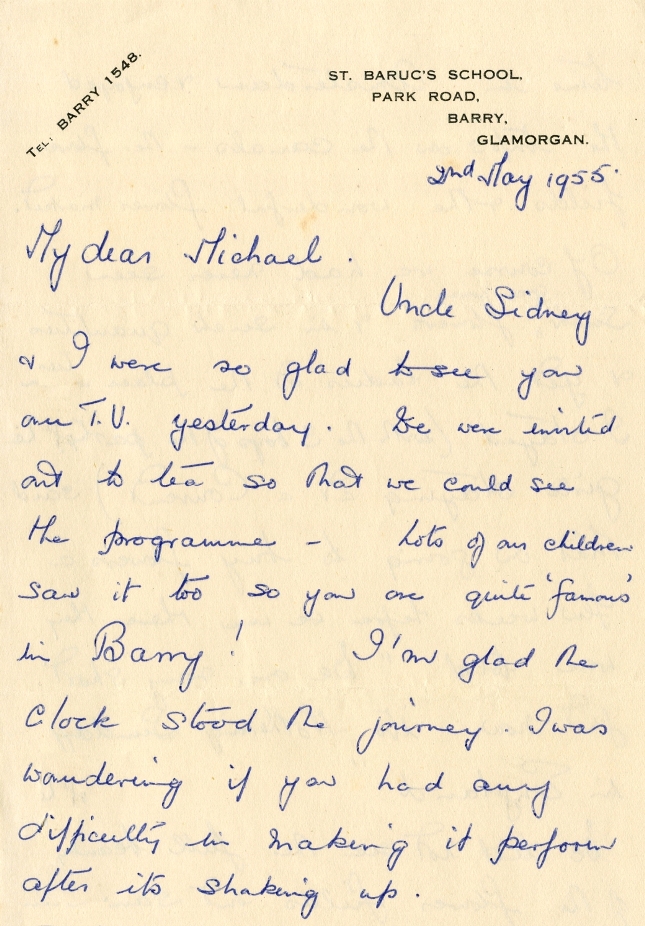 |
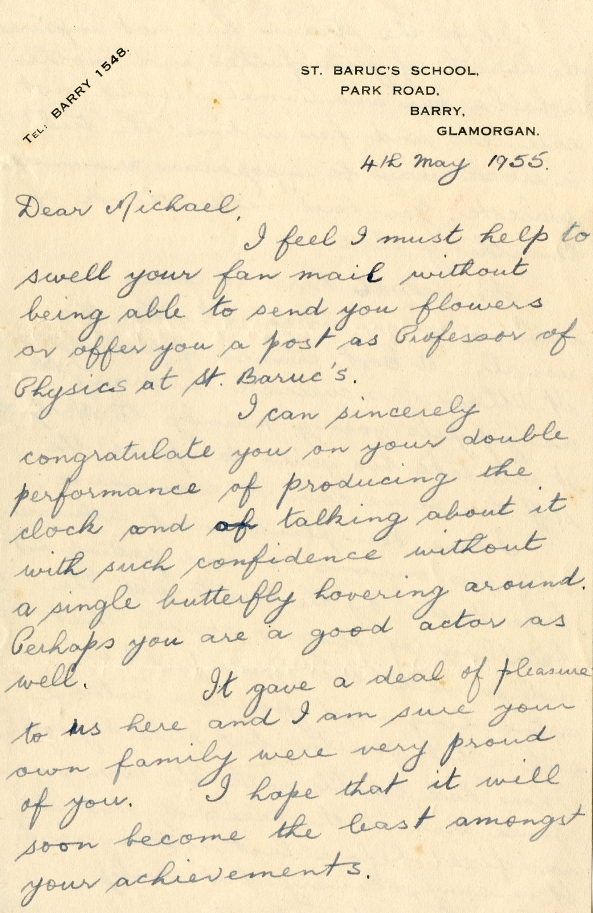 |
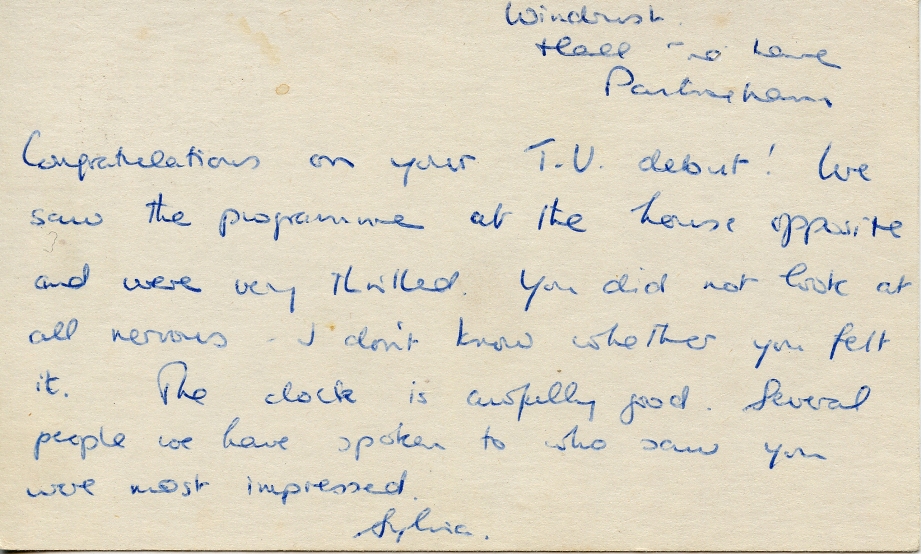 |
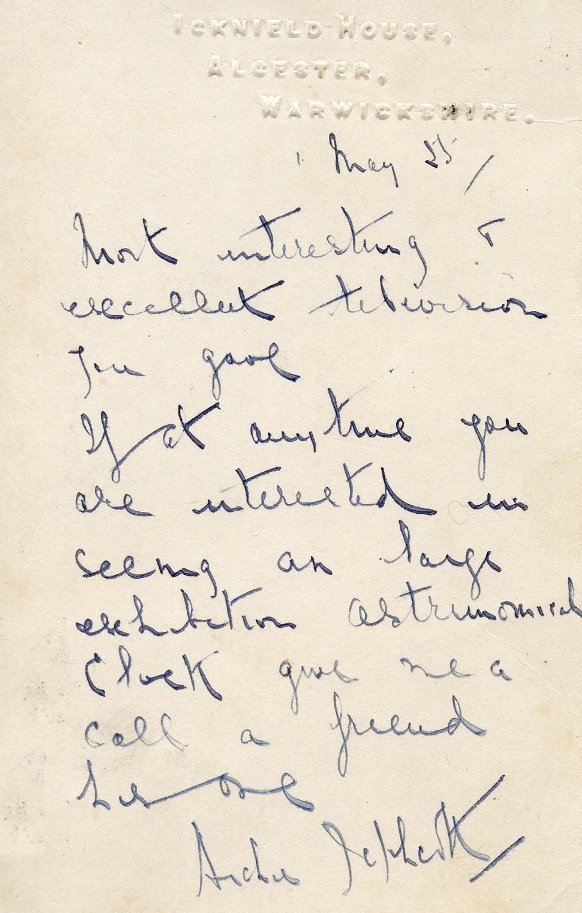 |
|
This letter below was the one that Michael was most interested in
from a job point of view and eventually he went and worked for the company after getting a First
Class Honours Degree in Electrical Engineering at University College
London.
|
|
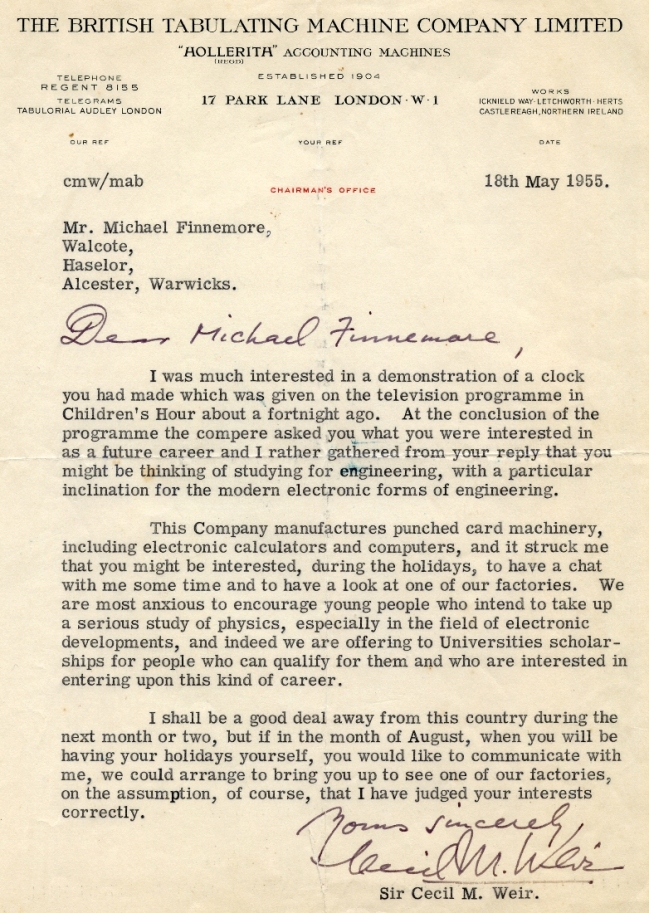 |
|
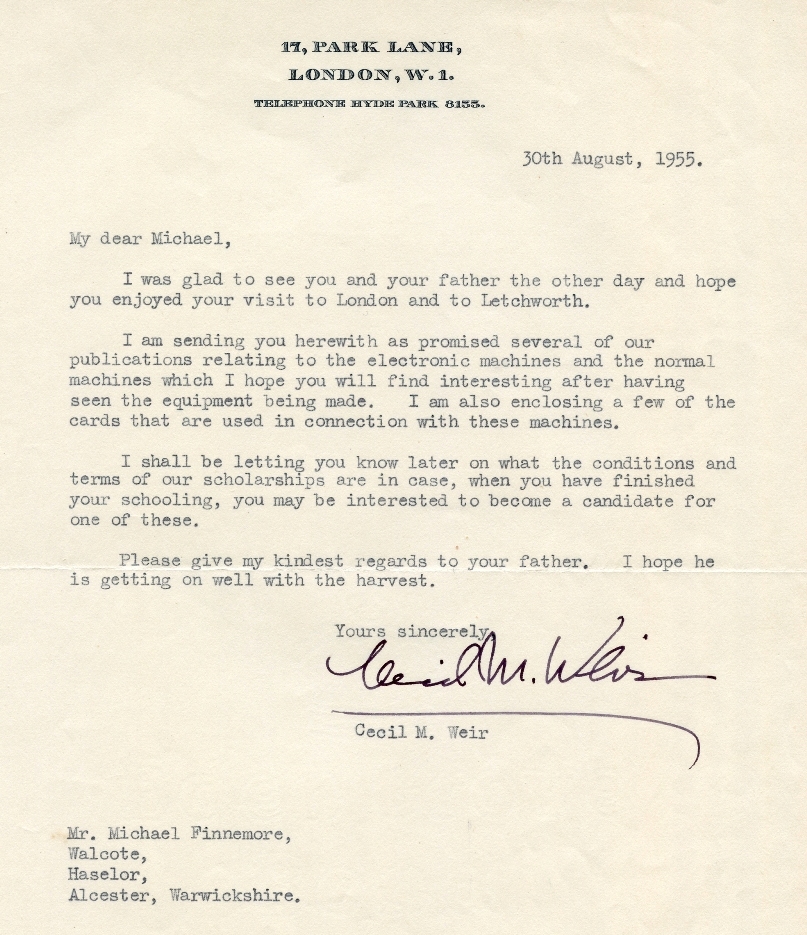 |
|
| From the Alcester Grammar School Magazine December 1955 | |
|
ELECTRONIC BRAINS
Electronics. This is a word of which we hear more and more every day.
Whenever we pick up the paper we read of some new development or use to
which this comparatively new science has been put. When I read about
these things, I wonder how it is all done, so you can imagine my delight
when, during the summer holidays, I was invited to look round the works
of a firm which specialises in the making of electronic calculating
machines. Of course I accepted the invitation, and a date was fixed for
me to go.
The tour started in the morning, when my father and I presented
ourselves at the firm's offices in Park Lane, London. Here we had a
demonstration of all the machines made by the firm, showing us the
numerous uses to which they could be put. All of them were not
electronically operated, but, nevertheless, they were all very
complicated.
The machines are all worked on the punch-card system. With this system
the data for any problem to be calculated is punched in a card in terms
of holes. The card is then fed into the machine, which distinguishes
between their positions and then types or punches the result at the
other end of the machine.
After dinner, we were taken out to Letchworth to see the actual building
of the machines. Here we saw the construction of tabulators, used by
large firms to work out their pay rolls, bills and many other jobs.
We then came on to the electronic section, where the building of
electronic computers was taking place. These gigantic machines, which
would completely cover one side of an average room, were just one mass
of wires and valves. There were so many valves, in fact, that the
machine had to he kept cool by means of a built-in fan.
With this machine it is possible to analyse, say, the
readings obtained from the test flights of aircraft or even calculate
the structure of a new chemical crystal. This is made possible by the
fact that it has a memory, and can remember data until it is ready to
bring it into use.
Another machine which I am sure would be very welcome
in the Science Sixth was the electronic calculator. This machine is able
to multiply, divide, add, subtract, or even work out equations, at the
rate of one hundred problems per minute.
All the machines are made with great precision, and
even the manufacture of the cards is no less than a work of art. These
cards, which are made of a special type of thin cardboard, have to he
made with a great accuracy and checked electrically for any impurity
which would otherwise have an effect on the machine.
These highly mathematical machines are becoming ever
more popular throughout the world for all manner of jobs, from the
filing of criminal records at Scotland Yard to the analysis of the last
census. The main emphasis, however, is always on research to improve and
to cut down costs, so who knows, the Science Sixth may yet get their
electronic calculator, hearing in mind that the present one costs about
£20,000 to build!
M. P. FINNEMORE (VI). |
|
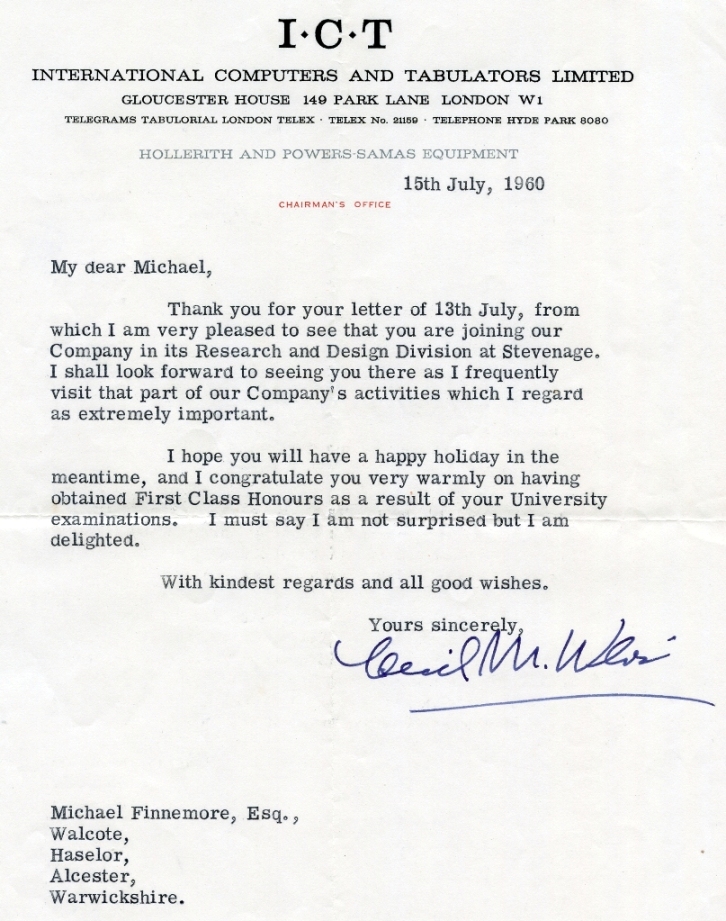 |
|
| ------------------------------------------------------- | |
| Before Making a Grandfather Clock | |
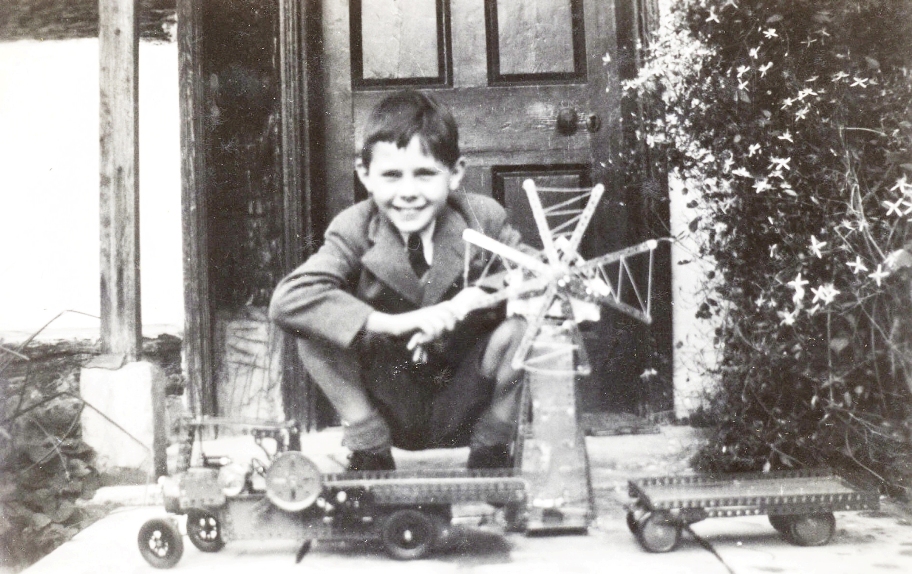 |
|
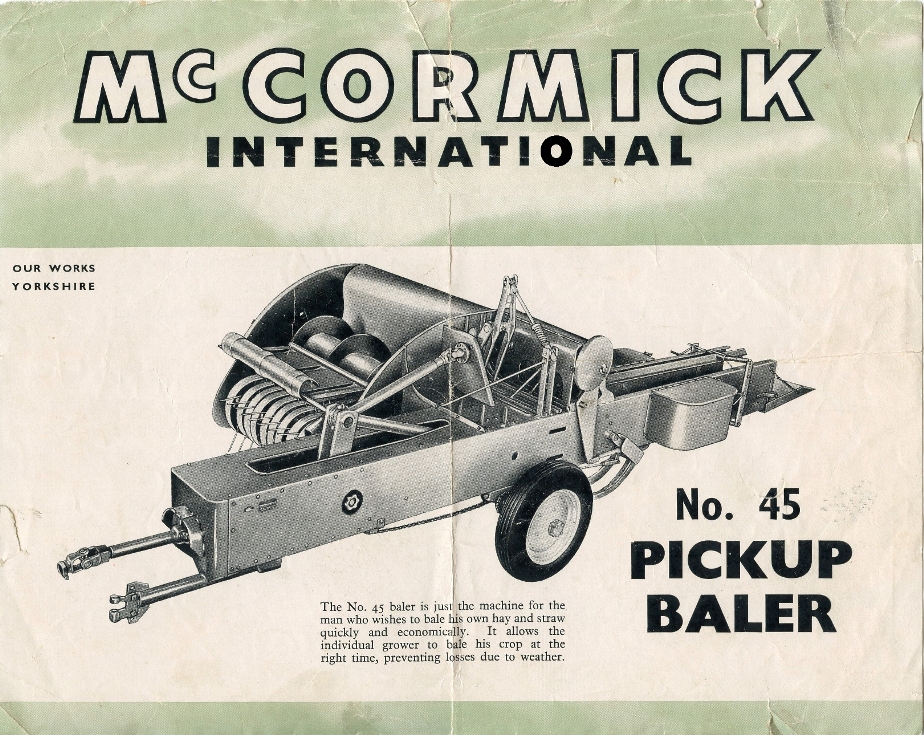 |
|
 |
|
| From the FARM IMPLEMENT & MACHINERY REVIEW AUGUST 1, 1951 | |
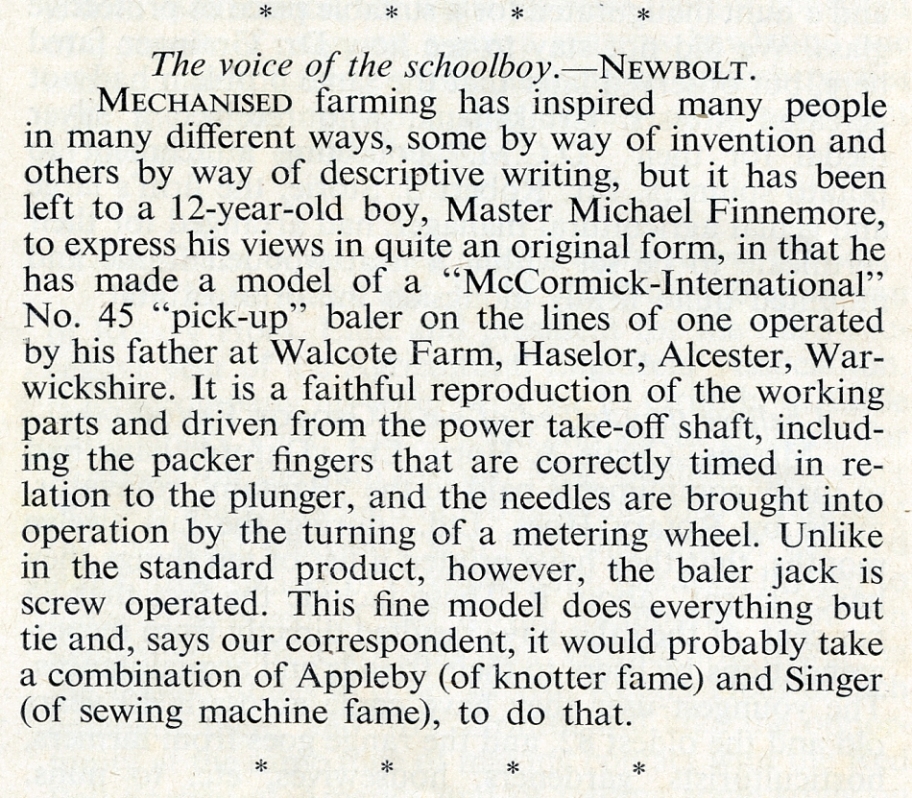 |
|
| MECCANO MAGAZINE OCTOBER 1951 | |
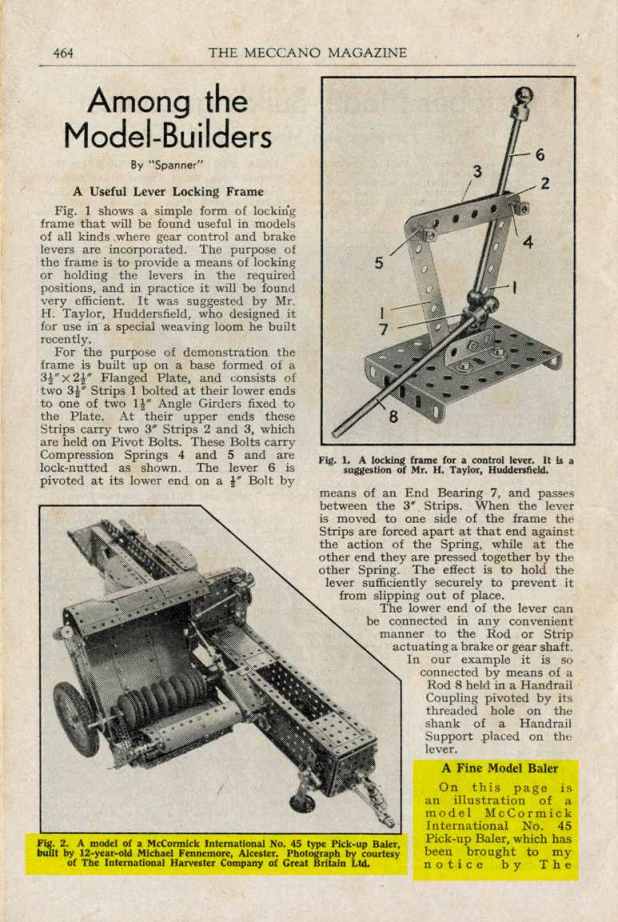 |
|
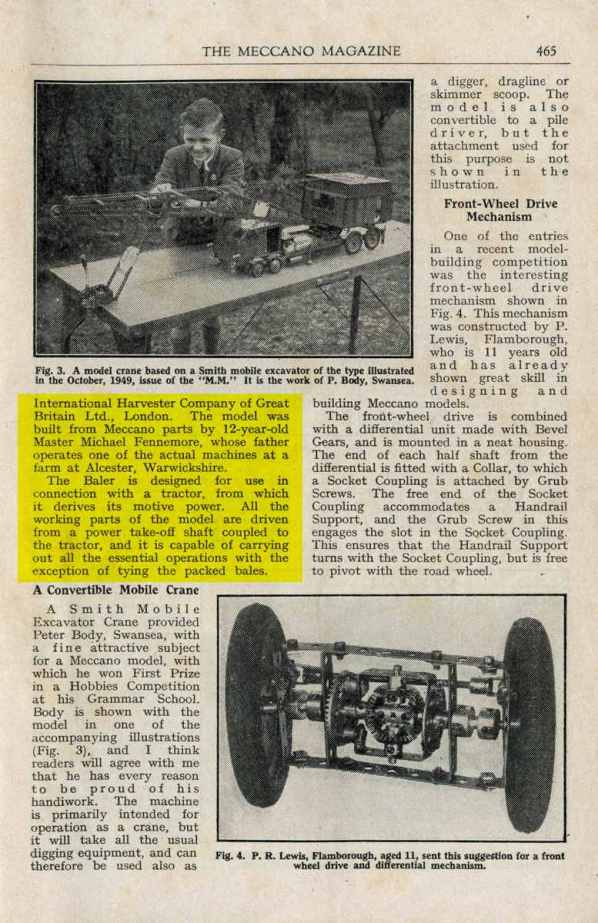 |
|
 |
|
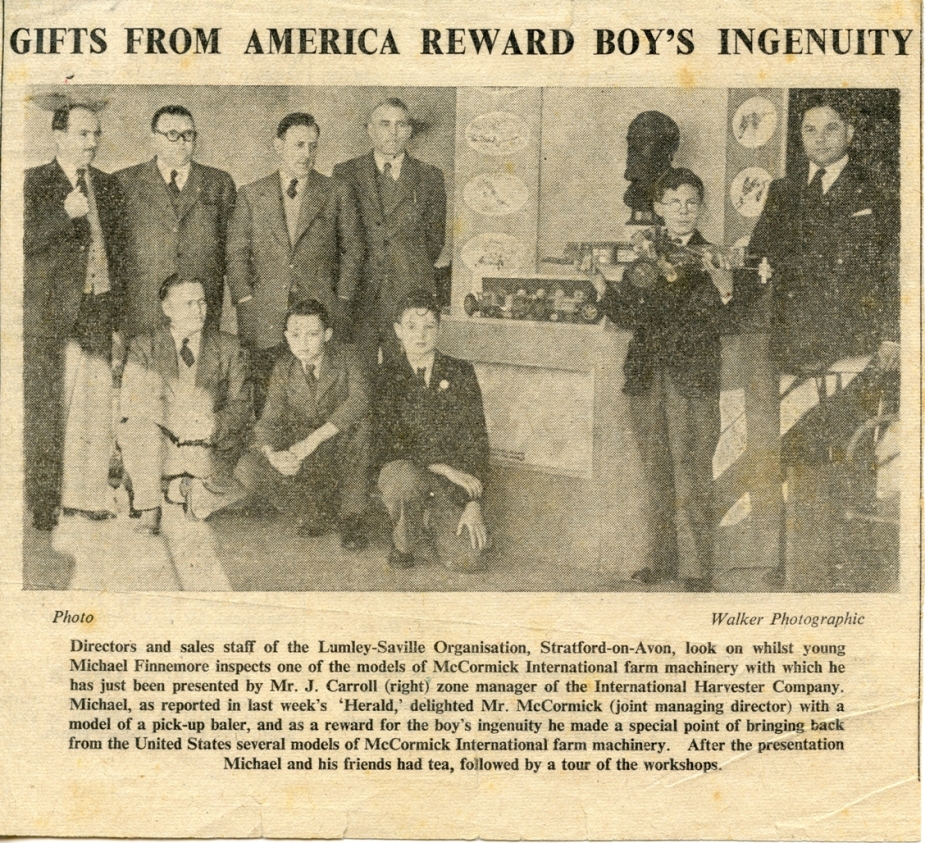 |
|
| My father Philip Finnemore is on the right in the back row. Michael's two friends are :- middle front row, John Aspinall | |
| and right front row, Antony Thornton. | |
|
|
|
| Models of McCormick International farm machinery brought over from America. | |
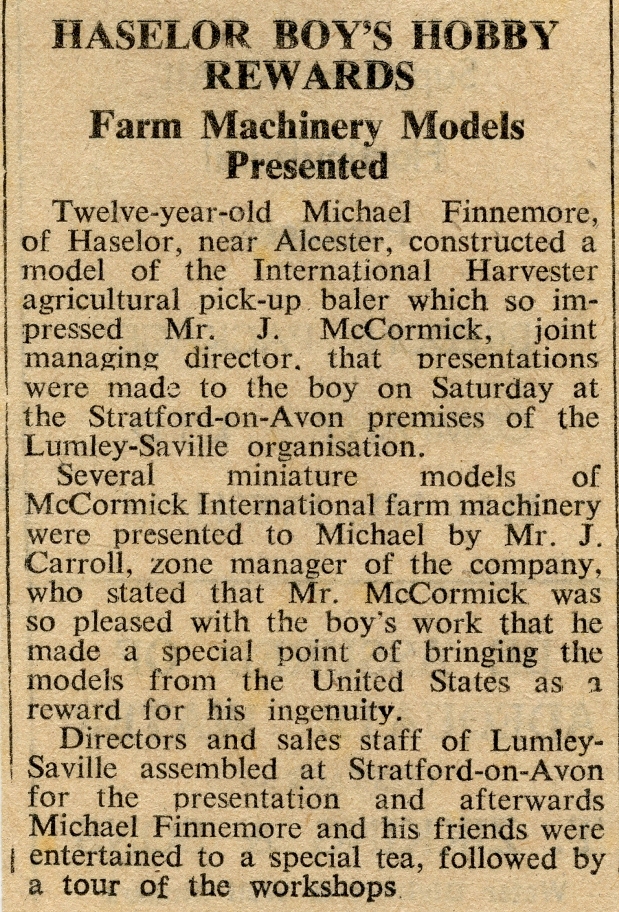 |
|
| ========================================== | |
| After Making a Grandfather Clock | |
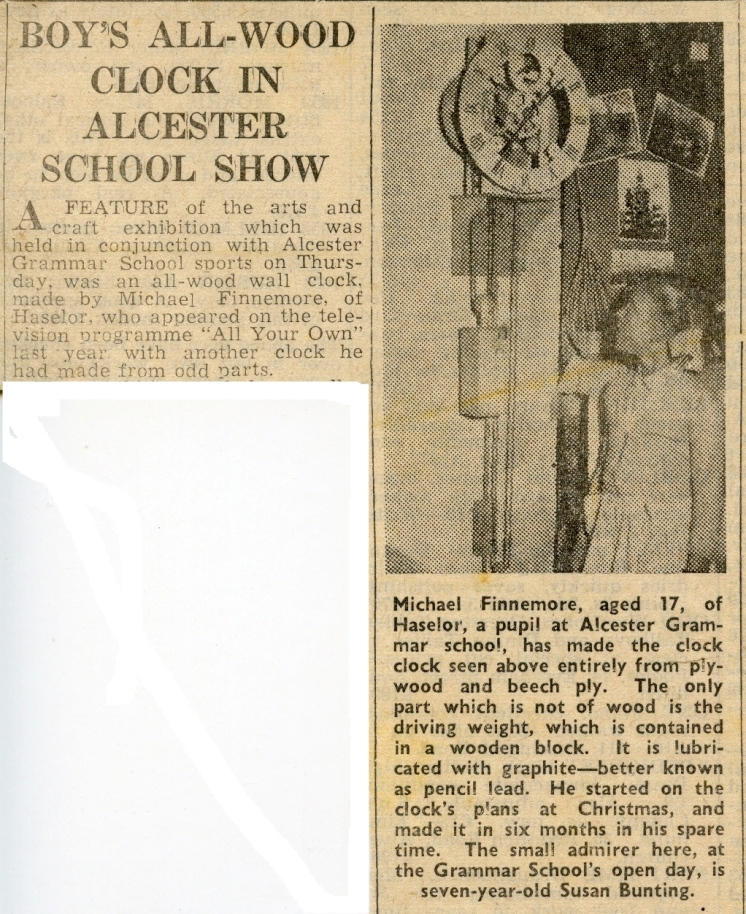 |
|
| Edited and Produced by John Finnemore, Walcote Farm, Walcote, Alcester. | |
| www.walcotefarm.co.uk | |
| If you have any comments or questions about this webpage, then please email me. | john@walcotefarm.co.uk |